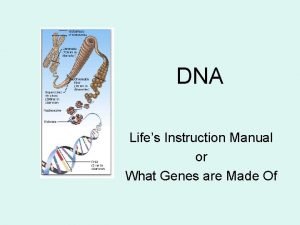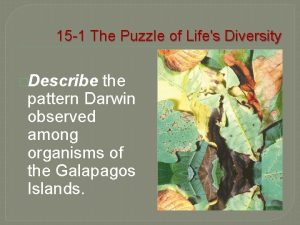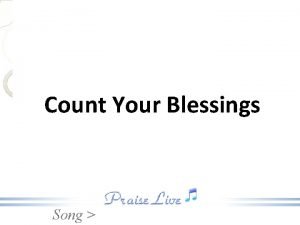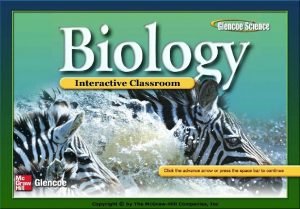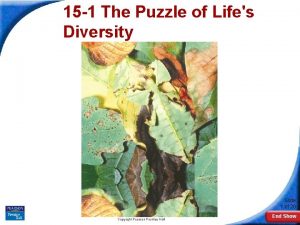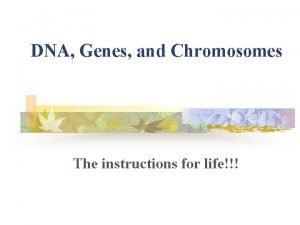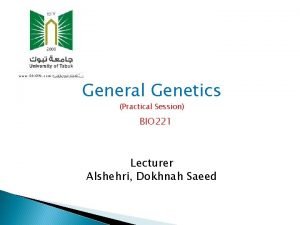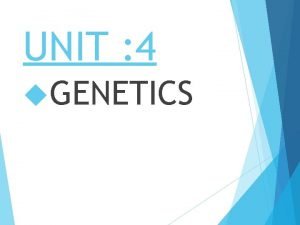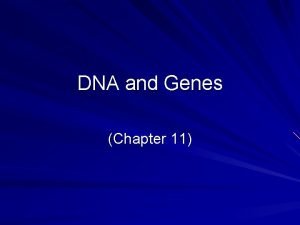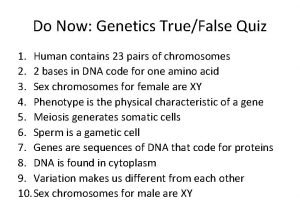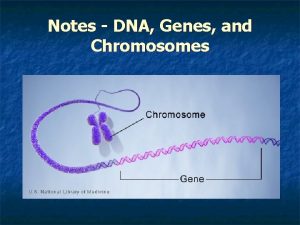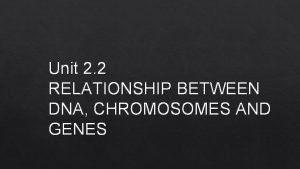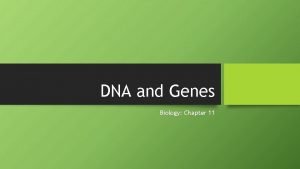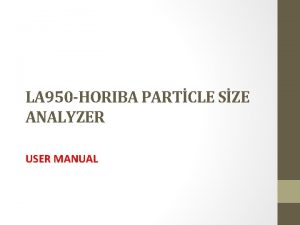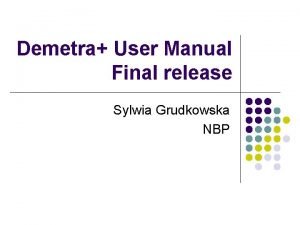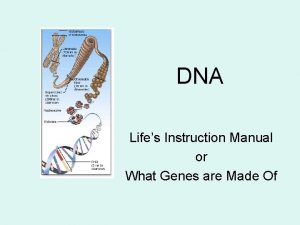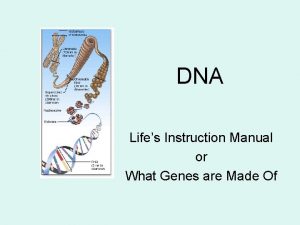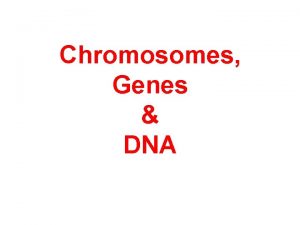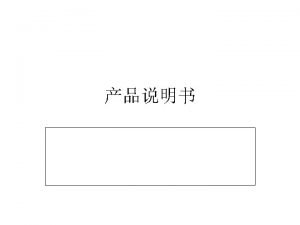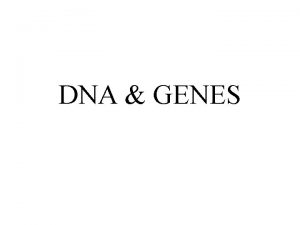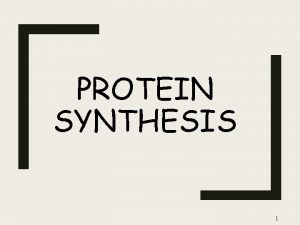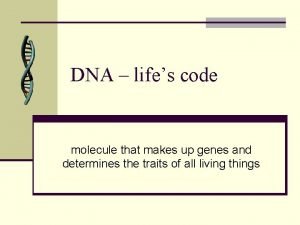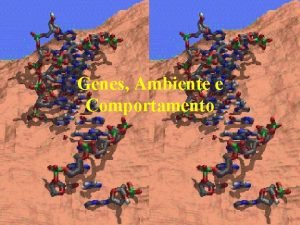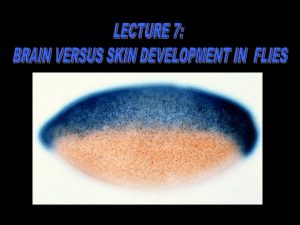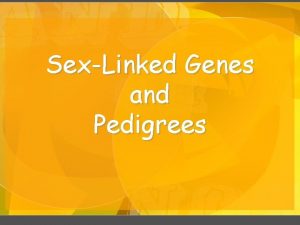DNA Lifes Instruction Manual or What Genes are




























- Slides: 28

DNA Life’s Instruction Manual or What Genes are Made Of

What can DNA do? • 1. Can replicate before cell division. Remember MEIOSIS and MITOSIS, chromosomes need to replicate before they divide • 2. Can direct protein synthesis. It tells the RIBOSOME to make a protein.

Why is the DNA the genetic material • DNA doubles prior to cell division (mitosis) • DNA divides equally between daughter cells • A body cell has 2 X the amount of DNA as a gamete(egg or sperm)

Discovery of DNA • 1952 Rosalind Franklin-studies DNA molecule using x-ray diffraction • 1953 Watson and Crick- develop double helix model

The Shape of the DNA Molecule • DNA is a complex organic molecule with a double helix shape. (a twisted ladder) • It consists of 2 phosphate-sugar backbones connected by a series of nucleotide bases. (colored letters)

DNA Nucleotide Bases • • • Adenine A Thymine T Guanine G Cytosine C These bases are joined together in a specific way… • A with T G with C • We call this base pairing.

DNA Structure

DNA Replication • The bonds between the base pairs are weak hydrogen bonds and can be broken easily. This means that the molecule can unwind and unzip itself. • Each side of the DNA molecule has all the information necessary to make a complementary (second) side. • Each piece of “old” DNA will act as a template for a “new” piece of DNA.

DNA Copies Itself!! • Because of base pairing, each strand of DNA can replicate itself making two new strands of DNA. • It uses extra nucleotide bases (in cell) to create this copy. • All of the work of DNA replication is done by enzymes!! • The main enzyme is called DNA polymerase

Semi-Conservative Replication • The result is that each new copy of DNA produced by this process is made up of ½ original DNA molecule and ½ new DNA molecule. This makes the process semi-conservative.

RNA • RNA is a nucleic acid like DNA • RNA is single stranded. • RNA does not contain thymine but instead has the base called uricil which bonds with adenine. • RNA has many functions in the cell, most importantly it is critical in the process of protein synthesis

Mutations • What happens when a mistake is made in replication of DNA? • Most mutations are NOT helpful!! But every so often, a beneficial mutation occurs (black moths)

Types of Mutations Point Mutations – the change in one single nucleotide base. substitution – one letter replaces another in the sequence. (ex. A->G) insertion – one letter is added to the sequence. (ex. a new T is added) deletion – one letter is removed from the sequence. (ex. a G is removed)

• Make a substitution in the following DNA ATTGCGTGTG ATTACGTGTG Make an insertion in the original sequence ATTGCGATGTG Make a deletion in the original sequence ATGCGTGTG

Larger Mutations • Inversions – when 2 or more bases (letters) are switched into reverse order. • Duplications – when bases are repeated in the original order more than one time. • Translocations – when bases are moved from one area of the sequence to another.

Make an 3 base inversion mutation in the following DNA sequence… ATTGCGTGTG ATCGTGTGTG Make a duplication of the inversion here ATCGTCGTGTGTG Make a translocation of 3 bases from another DNA sequence of T G C C A A to the original DNA ATTGCCCAAGTGTG

Protein Synthesis The Central Dogma • DNA holds the _______ to make Proteins • ____ transfers the CODE to the Ribosome • _______ are strings of amino acids coded for by DNA • Proteins are the “______” of the cell Structure, enzymes, communication, etc.

Transcription • The DNA message is _____ into an m. RNA message by complementary ______ pairing

Translation • The m. RNA then goes into the _____ to give the code for a protein to the ribosome. ______ (transfer) molecules will bring the correct _______ to the ribosome.


DNA

Mutations • Sometimes mistakes can be made in the copying process of DNA. Any change in the original sequence of base pairs is called a mutation.

Protein Synthesis The Central Dogma • DNA holds the CODE to make Proteins • RNA transfers the CODE to the Ribosome • Proteins are strings of amino acids coded for by DNA • Proteins are the “workhorses” of the cell Structure, enzymes, communication, etc.

Transcription • The DNA message is transcribed into an m. RNA message by complementary base pairing

Translation • The m. RNA then goes into the cytoplasm to give the code for a protein to the ribosome. t. RNA molecules will bring the correct amino acid to the ribosome.


DNA

Mutations • Sometimes mistakes can be made in the copying process of DNA. Any change in the original sequence of base pairs is called a mutation.
 Insidan region jh
Insidan region jh Life instruction manual
Life instruction manual Linked genes and unlinked genes
Linked genes and unlinked genes What are homeotic genes
What are homeotic genes Linked genes and unlinked genes
Linked genes and unlinked genes 4 lifers
4 lifers Section 15-1 the puzzle of lifes diversity
Section 15-1 the puzzle of lifes diversity When upon lifes billows
When upon lifes billows Organizing life's diversity section 3 domains and kingdoms
Organizing life's diversity section 3 domains and kingdoms Circle lifes
Circle lifes Section 15-1 the puzzle of lifes diversity
Section 15-1 the puzzle of lifes diversity Dna, genes and chromosomes relationship
Dna, genes and chromosomes relationship Dna genes
Dna genes Genes chromosomes dna
Genes chromosomes dna Dna and genes chapter 11
Dna and genes chapter 11 Dna chromosomes genes diagram
Dna chromosomes genes diagram Genes chromosomes and dna
Genes chromosomes and dna What is the relationship between dna chromosomes and genes
What is the relationship between dna chromosomes and genes Dna rna protein synthesis homework #2 dna replication
Dna rna protein synthesis homework #2 dna replication Chapter 11 dna and genes
Chapter 11 dna and genes What is a gene
What is a gene Differentiated instruction vs individualized instruction
Differentiated instruction vs individualized instruction § 367 abgb
§ 367 abgb Coding dna and non coding dna
Coding dna and non coding dna What role does dna polymerase play in copying dna?
What role does dna polymerase play in copying dna? Replication
Replication Bioflix activity dna replication lagging strand synthesis
Bioflix activity dna replication lagging strand synthesis Horiba la950
Horiba la950 Regressor instruction manual
Regressor instruction manual

